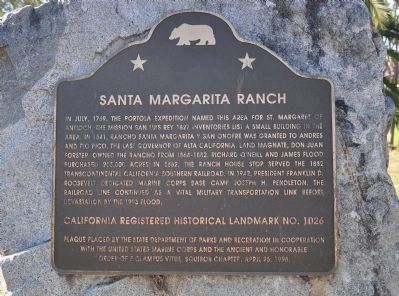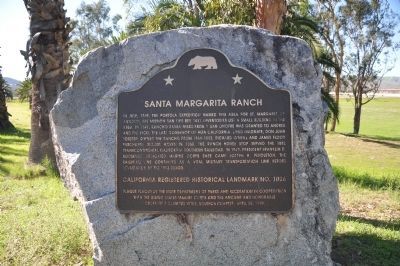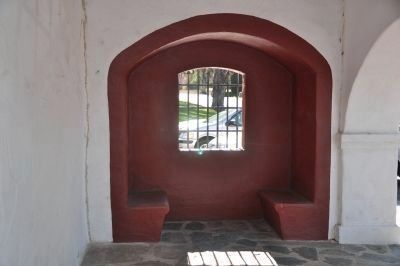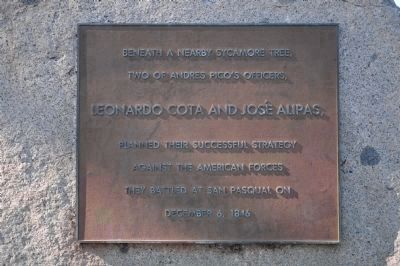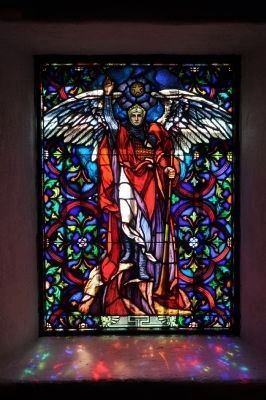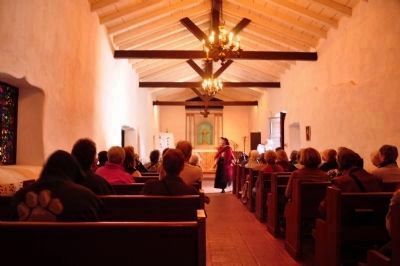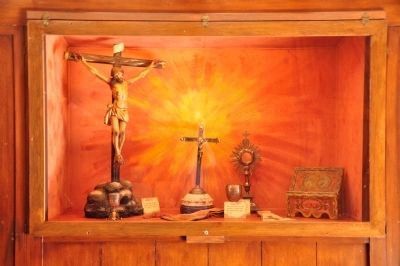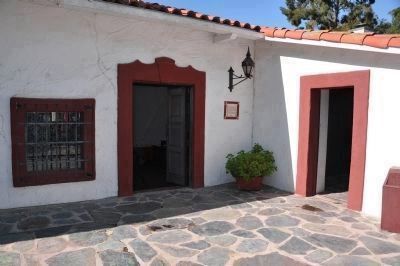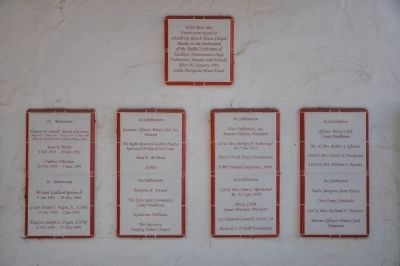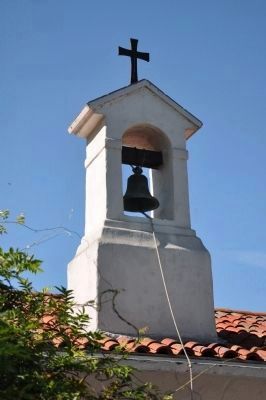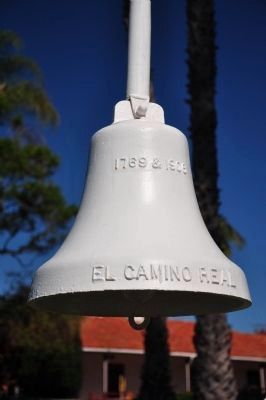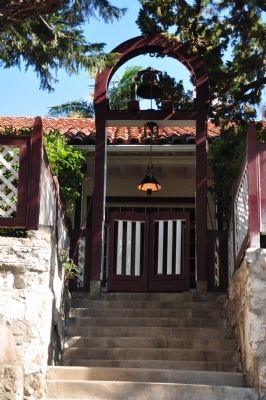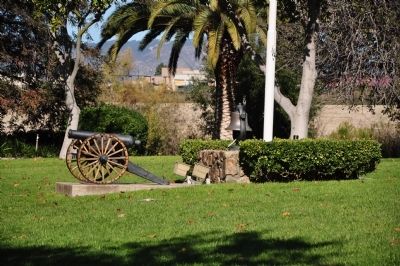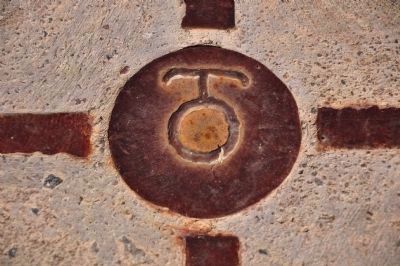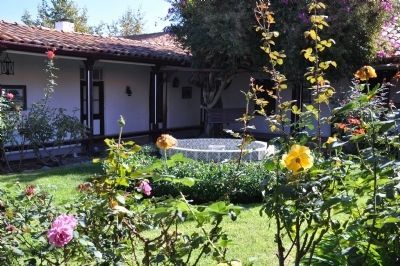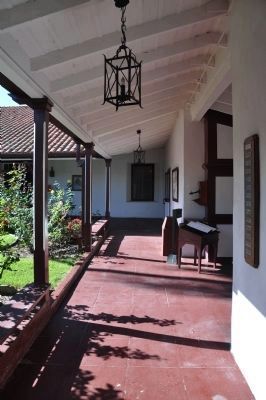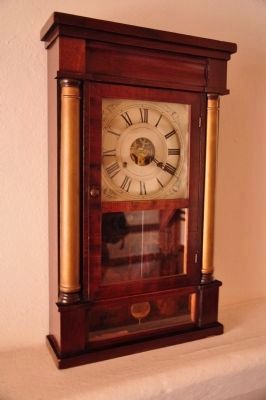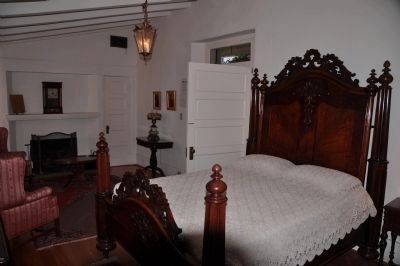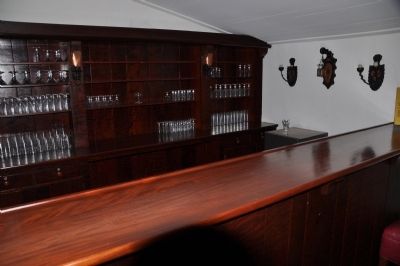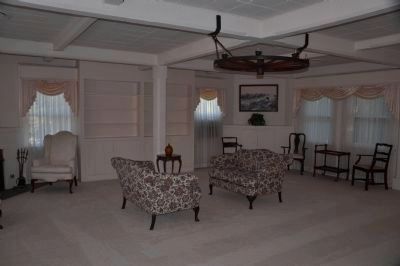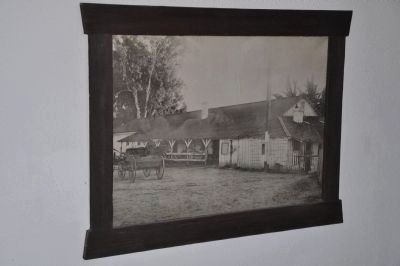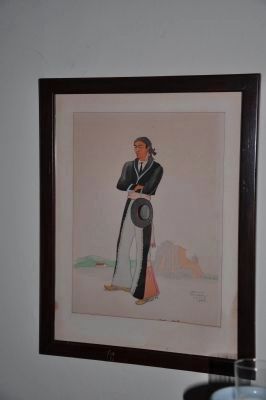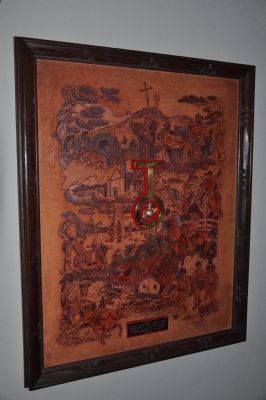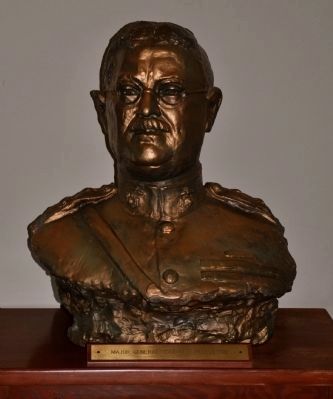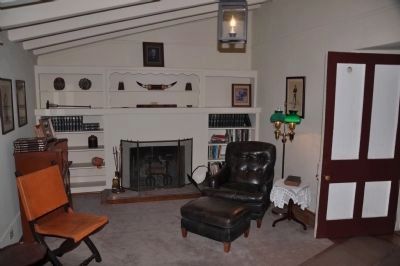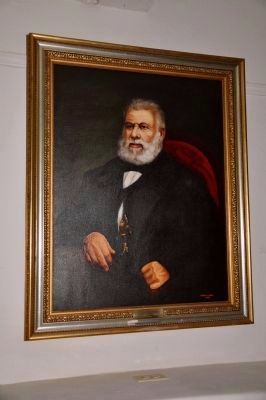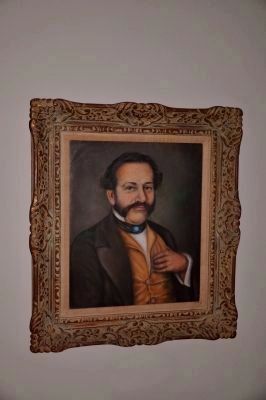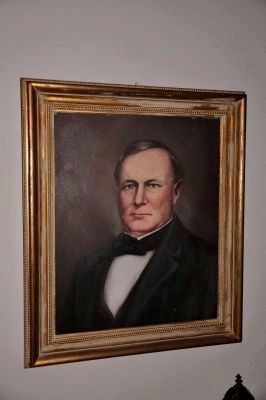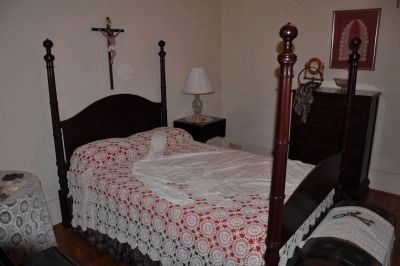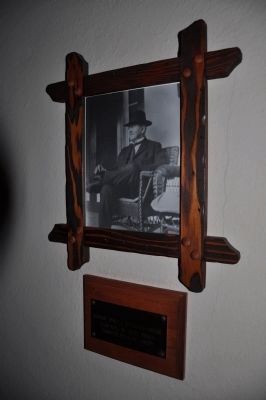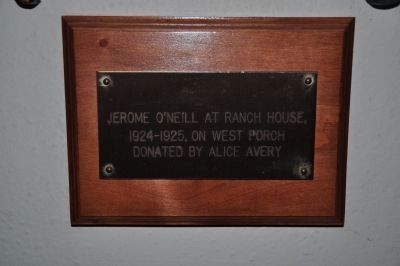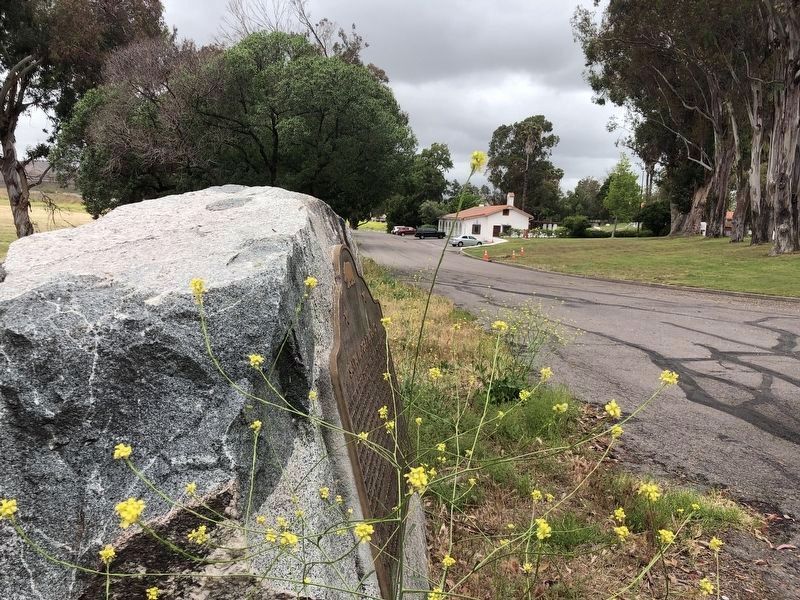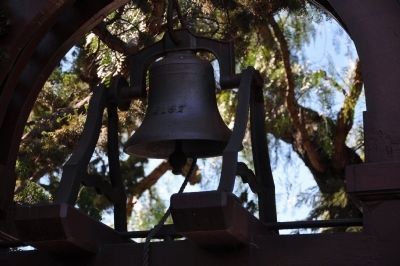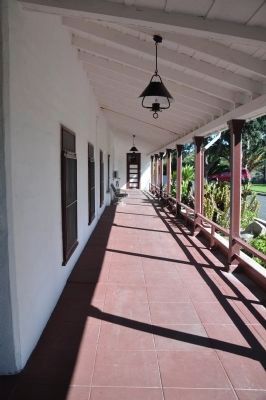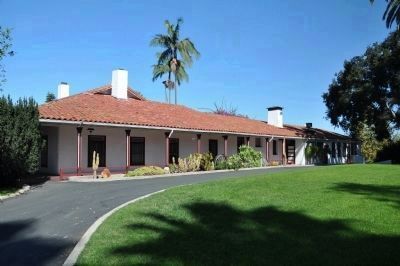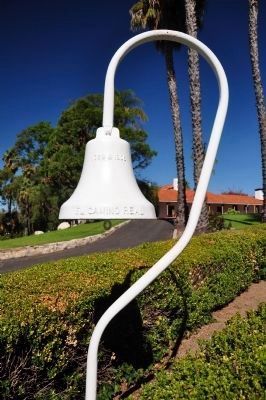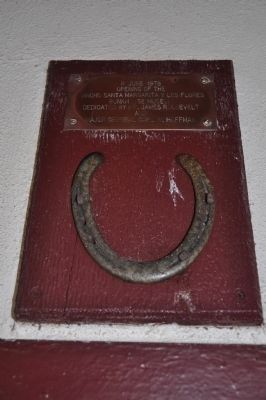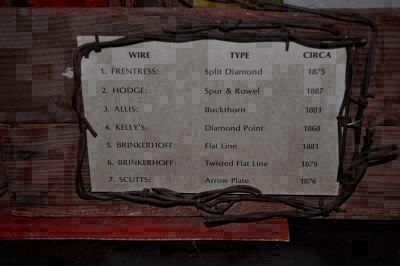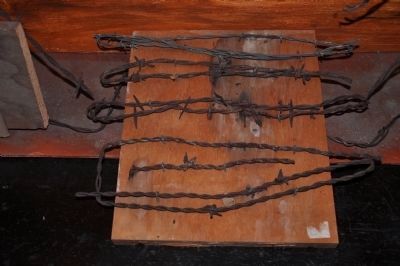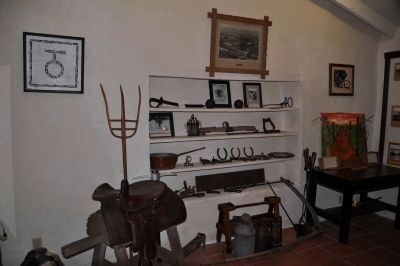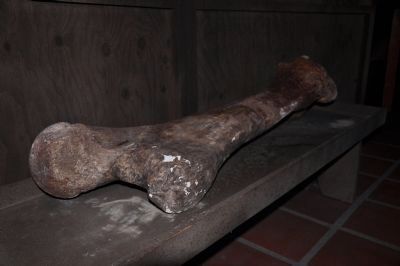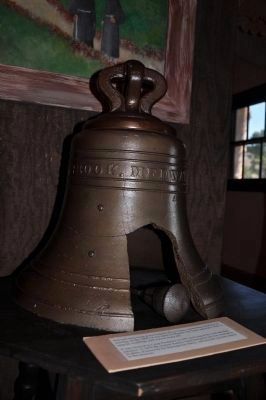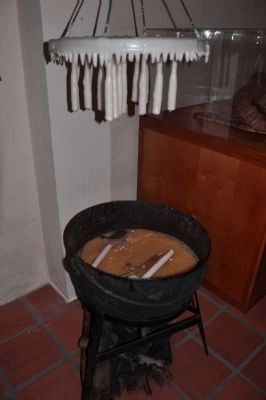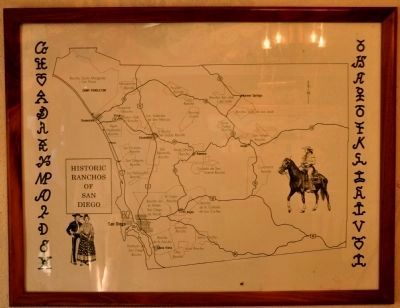Camp Pendleton South in San Diego County, California — The American West (Pacific Coastal)
Santa Margarita Ranch
Erected 1998 by State Department of Parks and Recreation in cooperation with the United States Marine Corps and the Ancient and Honorable Order of E Clampus Vitus, Squibob Chapter. (Marker Number 1026.)
Topics and series. This historical marker is listed in these topic lists: Notable Buildings • Railroads & Streetcars. In addition, it is included in the California Historical Landmarks, the E Clampus Vitus, and the Portolá Expedition series lists. A significant historical month for this entry is July 1769.
Location. 33° 18.486′ N, 117° 20.479′ W. Marker is in Camp Pendleton South, California, in San Diego County. Marker is on Vandegrift Boulevard, on the right when traveling south. Marker is located on the Marine Corps Base Camp Pendleton. Touch for map. Marker is in this post office area: Oceanside CA 92058, United States of America. Touch for directions.
Other nearby markers. At least 8 other markers are within 7 miles of this marker, measured as the crow flies. Leonardo Cota and Jose Alipas (about 400 feet away, measured in a direct line); The Santa Margarita Ranch House Bell (about 600 feet away); AH-1W "Super Cobra" (approx. 0.4 miles away); El Camino Real Bell (approx. 4 miles away); Walled Garden (approx. 5.2 miles away); Mission San Luís Rey de Francia (approx. 5.4 miles away); El Camino Real Guidepost Bells (approx. 6.1 miles away); Retreat Hell! (approx. 6.3 miles away). Touch for a list and map of all markers in Camp Pendleton South.
Also see . . .
1. Richard O'Neill (1824 - 1910) - Fina A Grave Memorial. (Submitted on January 8, 2012, by Michael Kindig of Elk Grove, California.)
2. Joseph H. Pendleton (1860 - 1942) - Find A Grave Memorial. (Submitted on January 8, 2012, by Michael Kindig of Elk Grove, California.)
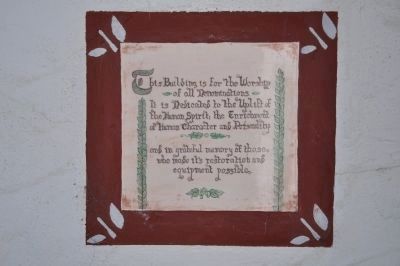
Photographed By Michael Kindig, November 9, 2010
8. Ranch House Chapel
of all Denominations.
It is Dedicated to the Uplift of
the Human Spirit; the Enrichment
of Human Character and Personality:
and in grateful memory of those
who made its restoration and
equipment possible.
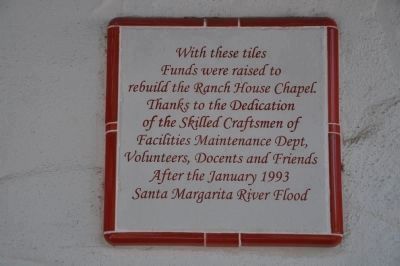
Photographed By Michael Kindig, November 9, 2010
11. Santa Margarita Ranch
Funds were raised to
rebuild the Ranch House Chapel.
Thanks to the Dedication
of the Skilled Craftsmen of
Facilities Maintenance Dept,
Volunteers, Docents and Friends
After the January 1993
Santa Margarita River Flood
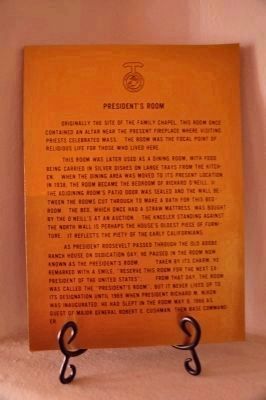
Photographed By Michael Kindig, November 9, 2010
21. President's Room
Originally the site of the family chapel, this room once contained an altar near the present fireplace where visiting priests celebrated mass. The room was the focal point of religious life for those who lived here.
This room was later used as a dining room, with food being carried in silver dishes on large trays from the kitchen. When the dining area was moved to its present location in 1938, the room became the bedroom of Richard O'Neill, Jr. The adjoining room's patio door was sealed and the wall between the rooms cut through to make a bath for this bedroom. The bed, which once had a straw mattress, was bought by the O'Neill's at an auction. The kneeler standing against the north wall is perhaps the house's oldest piece of furniture. It reflects the piety of the early Californians.
As president Roosevelt passed through the old adobe ranch house on dedication day, he paused in the room now known as the President's Room. Taken by its charm, he remarked with a smile, "Reserve this room for the next ex-President of the United States". From that day, the room was called "The President's Room", but it never lived up to its designation until 1969 when President Richard M. Nixon was inaugurated; he had slept in the room May 9, 1966 as guest of Major General Robert E. Cushman, then Base Commander.
This room was later used as a dining room, with food being carried in silver dishes on large trays from the kitchen. When the dining area was moved to its present location in 1938, the room became the bedroom of Richard O'Neill, Jr. The adjoining room's patio door was sealed and the wall between the rooms cut through to make a bath for this bedroom. The bed, which once had a straw mattress, was bought by the O'Neill's at an auction. The kneeler standing against the north wall is perhaps the house's oldest piece of furniture. It reflects the piety of the early Californians.
As president Roosevelt passed through the old adobe ranch house on dedication day, he paused in the room now known as the President's Room. Taken by its charm, he remarked with a smile, "Reserve this room for the next ex-President of the United States". From that day, the room was called "The President's Room", but it never lived up to its designation until 1969 when President Richard M. Nixon was inaugurated; he had slept in the room May 9, 1966 as guest of Major General Robert E. Cushman, then Base Commander.
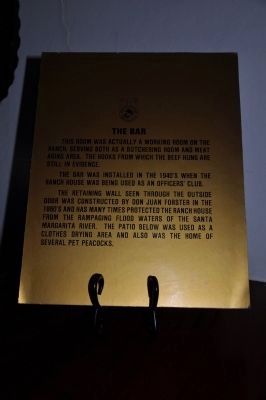
Photographed By Michael Kindig, November 9, 2010
25. The Bar
This room was actually a working room on the ranch, serving both as a butchering room and meat aging area. The hooks from which the beef hung are still in evidence.
The bar was installed in the 1940's when the ranch house was being used as an officer's club.
The retaining wall seen through the outside door was constructed by Don Juan Forester in the 1860's and has many times protected the ranch hose from the rampaging flood waters of the Santa Margarita River. The patio below was used as a clothes drying area and also was the home of several pet peacocks.
The bar was installed in the 1940's when the ranch house was being used as an officer's club.
The retaining wall seen through the outside door was constructed by Don Juan Forester in the 1860's and has many times protected the ranch hose from the rampaging flood waters of the Santa Margarita River. The patio below was used as a clothes drying area and also was the home of several pet peacocks.
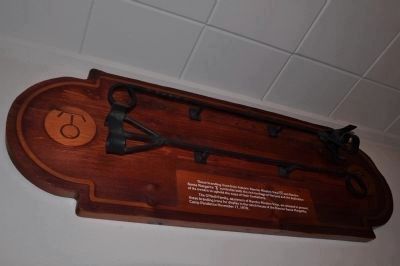
Photographed By Michael Kindig, November 9, 2010
26. Branding Irons
These branding irons from the historic Rancho Mission Viejo and Rancho Santa Margarita symbolize both the rich heritage of the land and the dedication of its owners to uphold the ways of their forefathers.
The O'Neill Family, as owners of Rancho Mission Viejo, are pleased to present present these branding irons for display in the ranch house of the Rancho Santa Margarita, Camp Pendleton November 17, 1978,
The O'Neill Family, as owners of Rancho Mission Viejo, are pleased to present present these branding irons for display in the ranch house of the Rancho Santa Margarita, Camp Pendleton November 17, 1978,
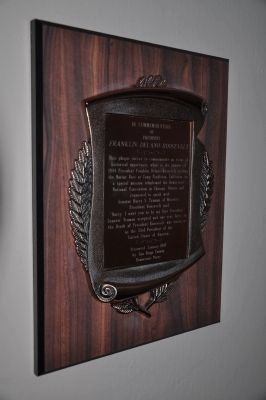
Photographed By Michael Kindig, November 9, 2010
30. Franklin Delano Roosevelt
President
Franklin Delano Roosevelt
This plaque serves to commemorate an event of historical importance, when in the summer of 1944 President Franklin Delano Roosevelt visiting the Marine Base at Camp Pendleton, California, on a special mission telephoned the Democratic National Convention in Chicago, Illinois and requested to speak with Senator Harry S. Truman of Missouri. President Roosevelt said, "Harry, I want you to be my Vice President." Senator Truman accepted and one year later, on the Death of President Roosevelt, was sworn in as the 33rd President of the United States of America.
Presented: January 1987
by: San Diego County Democratic Party
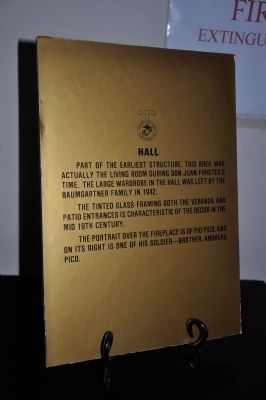
Photographed By Michael Kindig, November 9, 2010
37. Hall
Part of the earliest structure, this area was actually the living room during Don Juan Forester's time. The large wardrobe in the hall was left by the Baumgartner Family in 1942.
The tinted glass framing both the veranda and patio entrances is characteristic of the decor in the mid 19th Century.
The portrait over the fireplace is of Pio Pico and on its right is one of his soldier--brother, Andreas Pico.
The tinted glass framing both the veranda and patio entrances is characteristic of the decor in the mid 19th Century.
The portrait over the fireplace is of Pio Pico and on its right is one of his soldier--brother, Andreas Pico.
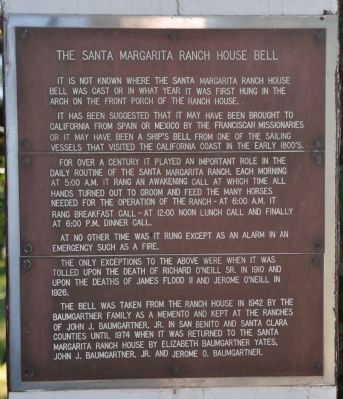
Photographed By Michael Kindig, November 9, 2010
43. Santa Margarita Ranch House Bell
It is not known where the Santa Margarita Ranch House bell was cast or in what year it was first hung in the arch on the front porch of the ranch house.
It has been suggested that it may have been brought to California from Spain or Mexico by the Franciscan Missionaries or it may have been a ship's bell from one of the sailing vessels that visited the California coast in the early 1800's.
For over a century it played an important role in the daily routine of the Santa Margarita Ranch. Each morning at 5:00 A.M. it rang an awakening call at which time all hands turned out to groom and feed the many horses needed for the operation of the ranch - at 6:00 A.M. it rang breakfast call - at 12:00 noon lunch call and finally at 6:00 P.M. dinner call.
At no other time was it rung except as an alarm in an emergency such as fire.
The only exceptions to the above were when it was tolled upon the death of Richard O'Neill Sr. in 1910 and upon the deaths of James Flood II and Jerome O'Neill in 1926.
The bell was taken from the ranch house in 1942 by the Baumgartner Family as a memento and kept at the ranches of John J. Baumgartner, Jr. in San Benito and Santa Clara Counties until 1874 when it was returned to the Santa Margarita Ranch House by Elizabeth Balmgartner Yates, John J. Baumgartner, Jr. and Herome O. Baumgartner.
It has been suggested that it may have been brought to California from Spain or Mexico by the Franciscan Missionaries or it may have been a ship's bell from one of the sailing vessels that visited the California coast in the early 1800's.
For over a century it played an important role in the daily routine of the Santa Margarita Ranch. Each morning at 5:00 A.M. it rang an awakening call at which time all hands turned out to groom and feed the many horses needed for the operation of the ranch - at 6:00 A.M. it rang breakfast call - at 12:00 noon lunch call and finally at 6:00 P.M. dinner call.
At no other time was it rung except as an alarm in an emergency such as fire.
The only exceptions to the above were when it was tolled upon the death of Richard O'Neill Sr. in 1910 and upon the deaths of James Flood II and Jerome O'Neill in 1926.
The bell was taken from the ranch house in 1942 by the Baumgartner Family as a memento and kept at the ranches of John J. Baumgartner, Jr. in San Benito and Santa Clara Counties until 1874 when it was returned to the Santa Margarita Ranch House by Elizabeth Balmgartner Yates, John J. Baumgartner, Jr. and Herome O. Baumgartner.
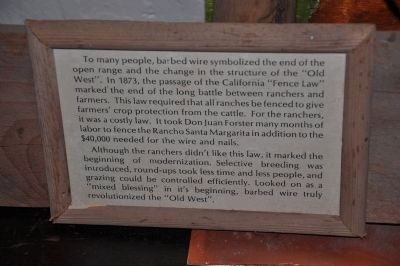
Photographed By Michael Kindig, November 9, 2010
50. Barbed Wire Display
To many people, barbed wire symbolizes the end of the open range and the change in the structure of the "Old West". in 1873, the passage of the California "Fence Law" marked the end of the long battle between ranchers and farmers. This law required that all ranches be fenced to give farmers' crop protection from the cattle. For the ranchers, it was a costly law. It took Don Juan Forster many months of labor to fence the Rancho Santa Margarita in addition to the $40,000 needed for the wire and nails.
Although the ranchers didn't like the law, it marked the beginning of modernization. Selective breeding was introduced, round-ups took less time and less people, and grazing could be controlled efficiently. Looked on as a "mixed blessing" in it's beginning, barbed wire truly revolutionized the "Old West".
Although the ranchers didn't like the law, it marked the beginning of modernization. Selective breeding was introduced, round-ups took less time and less people, and grazing could be controlled efficiently. Looked on as a "mixed blessing" in it's beginning, barbed wire truly revolutionized the "Old West".
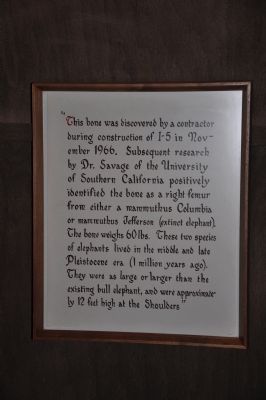
Photographed By Michael Kindig, November 9, 2010
52. Pleistocene Era Bone
"This bone was discovered by a contractor during construction of I-5 in November 1966. Subsequent research by Dr. Savage of the University of Southern California positively identified the bone as a right femur from either a mammuthus Columbia or mammuthus Jefferson (extinct elephant). The bone weighs 60 lbs. These two species of elephants lived in the middle and late Pleistocene era (1 million years ago). They were as large or larger than the existing bull elephant, and were approximately 12 feet high at the Shoulders"
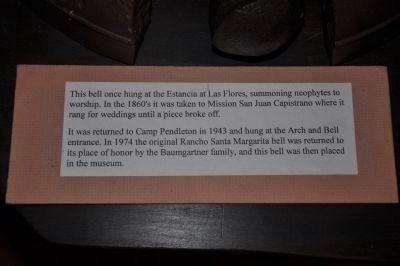
Photographed By Michael Kindig, November 9, 2010
54. Las Flores Estancia Bell
This bell once hung at the Estancia at Las Flores, summoning neophytes to worship. In the 1860's it was taken to Mission San Juan Capistrano where it rang for weddings until a piece broke off.
It was returned to Camp Pendleton in 1943 and hung at the Arch and Bell entrance. In 1974 the original Rancho Santa Margarita bell was returned to its place of honor by the Baumgartner family, and this bell was then placed in the museum.
It was returned to Camp Pendleton in 1943 and hung at the Arch and Bell entrance. In 1974 the original Rancho Santa Margarita bell was returned to its place of honor by the Baumgartner family, and this bell was then placed in the museum.
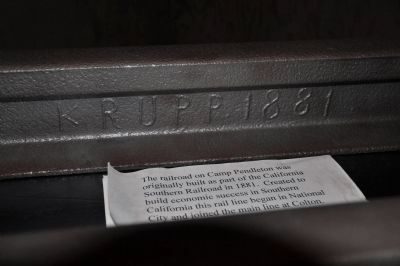
Photographed By Michael Kindig, November 9, 2010
58. Southern Railroad (1881)
The railroad on Camp Pendleton was originally built as part of the California Southern Railroad in 1881. Created to build economic success in Southern California this rail line began in National City and joined the main line at Colton. In 1891 and again in 1916, the railroad was washed out.
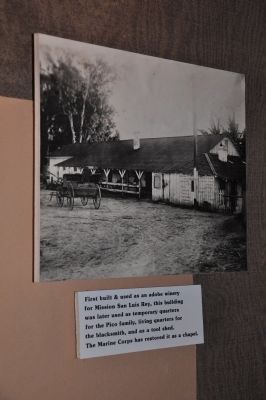
Photographed By Michael Kindig, November 9, 2010
59. Santa Margarita Ranch
First built & used as an adobe winery for Mission San Luis Rey, this building was later used as temporary quarters for the Pico family, living quarters for the blacksmith, and as a tool shed. The Marine Corps has restored it as a chapel.
Credits. This page was last revised on March 26, 2024. It was originally submitted on December 29, 2011, by Michael Kindig of Elk Grove, California. This page has been viewed 2,494 times since then and 57 times this year. It was the Marker of the Week June 3, 2012. Photos: 1. submitted on December 30, 2011, by Michael Kindig of Elk Grove, California. 2, 3, 4, 5. submitted on January 5, 2012, by Michael Kindig of Elk Grove, California. 6, 7, 8, 9, 10, 11, 12, 13, 14, 15, 16, 17, 18, 19, 20, 21, 22, 23, 24, 25, 26, 27, 28, 29, 30, 31, 32, 33, 34, 35, 36, 37, 38, 39, 40. submitted on January 8, 2012, by Michael Kindig of Elk Grove, California. 41. submitted on May 23, 2019, by Col. James F. Jamison, USMC (Ret) of Coronado, California. 42, 43, 44. submitted on January 8, 2012, by Michael Kindig of Elk Grove, California. 45. submitted on December 31, 2011, by Michael Kindig of Elk Grove, California. 46, 47, 48, 49, 50, 51, 52, 53, 54, 55, 56, 57, 58, 59. submitted on January 8, 2012, by Michael Kindig of Elk Grove, California. • Syd Whittle was the editor who published this page.
